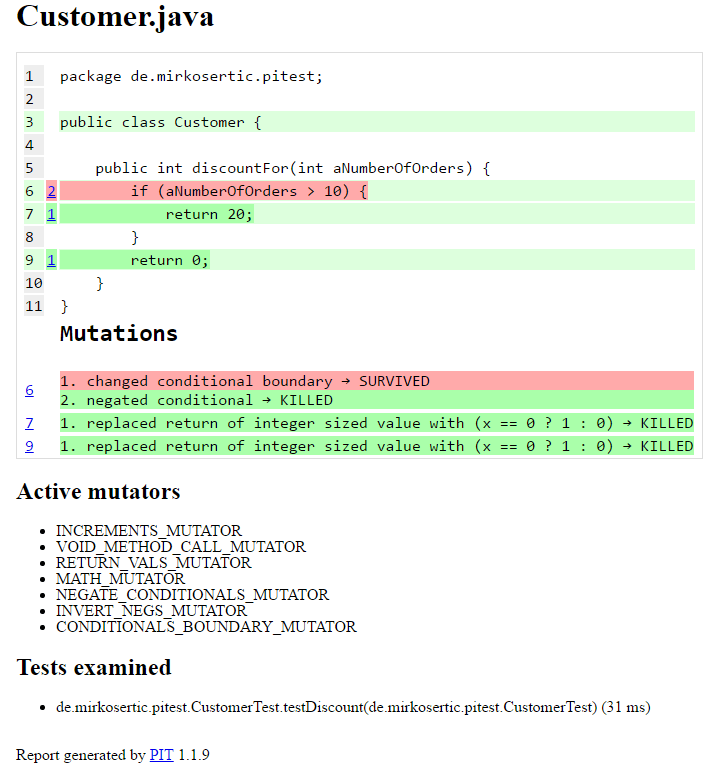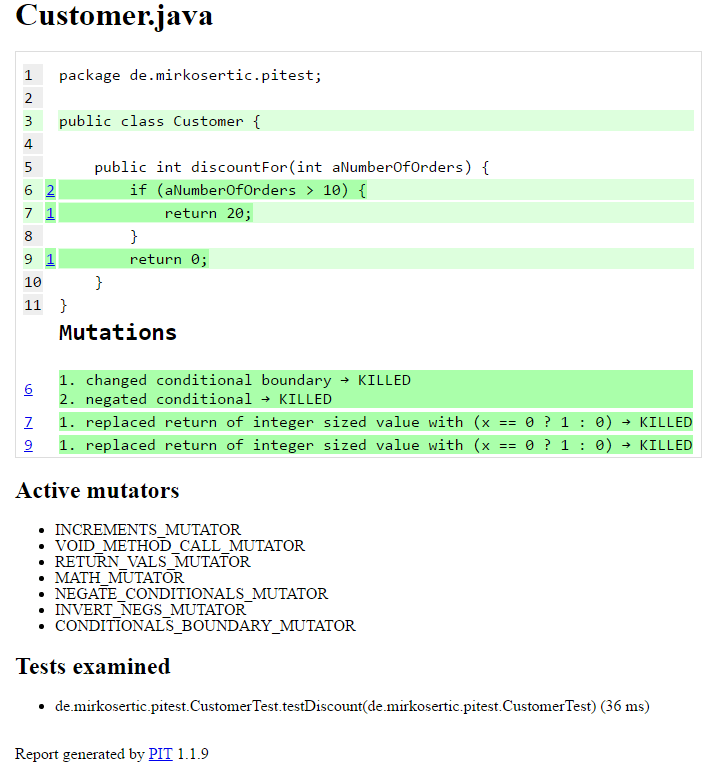A very common problem
Unit testing is a today must have. Together with Test-driven Development and Frameworks such as JUnit we can easily prove that our code fulfills a set of requirements and business invariants. We use metrics like "Test coverage" to get insight about the completeness of our tests. A very common assumption taken from a test coverage of 80 percent is that 80 percent of our code is tested and working correctly.
This code coverage thinking can be a big problem. In fact, the code coverage doesn’t say anything about the quality of our tests. It just proves that 80 percent of the example above were executed by our unit tests. It doesn’t say that the 80 percent are working correctly, and it doesn’t say that the unit test is able to detect defects of any kind in our code. The most extreme example is a unit test without assertions. It may give a high test coverage, but it doesn’t test anything at all. Therefore a test coverage of 80 percent only proves for sure that 20 percent of our code is definitely not tested at all.
What to do?
Well, we need another metric to measure the effectiveness of our tests, so we know that the 80 percent test coverage is indeed able to detect any kind of defect. And here comes a technique called Mutation testing to play.
Mutation testing basically adds mutation(errors) to the code and checks if the unit tests fail if a mutation was inserted.
This is also called fault seeding.
Every detected mutation is marked as "killed", all other mutations are marked as "survived".
The effectiveness of our tests can then be gauged as the ratio of survived and killed mutations.
How to apply this technique?
Prior mutation testing systems required complex setups and special language compiler. But fortunately there is a bright shining star available to the Java world. Say hello to PITest!
PITest is basically a Maven plugin that can easily be added to existing projects. It runs the unit tests with a configured set of mutation operations and reports the killed and survived mutations as XML reports for machine processing and fancy HTML reports fur human eyes. It can also easily be integrated with source code quality tools such as SonarQube.
<plugin>
<groupId>org.pitest</groupId>
<artifactId>pitest-maven</artifactId>
<version>1.1.9</version>
</plugin>A simple example
Let me show you how PITest can help us to improve unit test quality.
Given the following source code:
package de.mirkosertic.pitest;
public class Customer {
public int discountFor(int aNumberOfOrders) {
if (aNumberOfOrders > 10) {
return 20;
}
return 0;
}
}We run the following test:
package de.mirkosertic.pitest;
import org.junit.Test;
import static org.junit.Assert.*;
public class CustomerTest {
@Test
public void testDiscount() {
Customer theCustomer = new Customer();
assertEquals(0, theCustomer.discountFor(5));
assertEquals(20, theCustomer.discountFor(20));
}
}We get a very high test coverage for this test:

Now, let us see what happens if we apply some mutation testing. We get the following report:

Indeed, this is bad. It seems the unit test is missing some boundary conditions. We have to improve the test as seen here:
package de.mirkosertic.pitest;
import org.junit.Test;
import static org.junit.Assert.*;
public class CustomerTest {
@Test
public void testDiscount() {
Customer theCustomer = new Customer();
assertEquals(0, theCustomer.discountFor(5));
assertEquals(0, theCustomer.discountFor(9));
assertEquals(0, theCustomer.discountFor(10));
assertEquals(20, theCustomer.discountFor(11));
assertEquals(20, theCustomer.discountFor(20));
}
}Now, let us check with mutation testing again:

Ahh, this is much better. Now, we have a very good test for our code.
Code review system integration
It would be very cool to integrate mutation testing as an automated quality control into our code review system. The problem might be that mutation testing is very CPU demanding, and a full mutation testing run for every single, maybe small, commit might be an overkill and slow down the review life cycle.
PITest has an integrated feature for code review system integration. It can be started with a special option to analyze the changes of the last SCM commit only. Please take a look at the scmMutationCoverage goal in the PITest Maven Documentation. This feature greatly increases review round trip time.
If you want so see this feature in action, please visit Maven-Sonar-Sputnik Plugin. This small tool helps to integrate PITest with Sonar and Gerrit.
Where are the limitations?
Well, every tool has its limitations. PITest works fast and transparent for all kind of unit tests. When it comes to more complex test scenarios such as integration tests with in-process databases, PITest will still give results, but it might take hours to complete. So a good strategy is so run the real unit test with PITest, and try to archive a test and mutation coverage as high as we get. Then we use integration test to test complete use cases, but here the orchestration of already tested code is the focus and we test only the orchestration logic.
Also, it is not good to insist on a 100 percent mutation coverage, as this misses the same point as insisting on a 100 percent test coverage. There a certain conditions(logging for instance) that are very hard to test and are highly dependent on the configuration of the underlying system(logging configuration), In such situations it would definitely make more sense to spend your time with writing more integration tests instead of trying to get the last remaining percent of the test metric.
Conclusion
Mutation testing can help us to identify leakages in our tests. It gives us a simple metric that can help us to improve the quality of our unit tests. Frameworks such as PITest can easily be added to existing projects and can do things in minutes that prior system took days to complete. I really love mutation testing!
